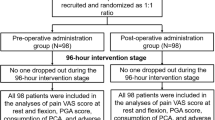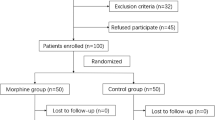Abstract
To assess the efficacy of postoperative pain management and the concentration change of PGE-2 and IL-6 of joint fluid with parecoxib after postoperative total knee arthroplasty. In the study, 100 patients experiencing primary TKA were randomly divided into study group, receiving parecoxib sodium (40 mg) intravenously (IV) at the completion of surgery and once every 12 h for totally 6 times postoperatively, and placebo group, receiving normal saline 2 mL IV at the same time points. Efficacy was assessed by total amount of morphine consumed, pain intensity, range of motion (ROM), the concentration change of PGE-2 and IL-6 of joint fluid, and postoperative nausea and vomiting (PONV) postoperatively. Patients in study group consumed significantly less morphine, experienced significant less pain scores, and obtained significantly more ROM (P < 0.01) compared with that in placebo group during 3 days postoperatively. The concentration of PGE-2 and IL-6 of joint fluid in study group are significantly lower than that in placebo group (P < 0.01) during 24 h postoperatively. The overall incidence of PONV was low and was not significantly different between the two groups. The present study demonstrated that the perioperative administration of parecoxib after primary TKA resulted in significantly improved postoperative analgesic management as defined by reduction in opioid requirement, lower pain scores and ROM, and significantly lowered local inflammation factors PGE2 and IL-6.







Similar content being viewed by others
References
Dorr LD, Raya J, Long WT, Boutary M, Sirianni LE (2008) Multimodal analgesia without parenteral narcotics for total knee arthroplasty. J Arthroplasty 23:502–508
Ranawat AS, Ranawat CS (2007) Pain management and accelerated rehabilitation for total hip and total knee arthroplasty. J Arthroplasty 22:12–15
Meunier A, Lisander B, Good L (2007) Effects of celecoxib on blood loss, pain, and recovery of function after total knee replacement: a randomized placebo-controlled trial. Acta Orthop 78:661–667
Bennett D, Hanratty B, Thompson N, Beverland DE (2009) The influence of pain on knee motion in patients with osteoarthritis undergoing total knee arthroplasty. Orthopedics 32:296–299
Maheshwari AV, Blum YC, Shekhar L, Ranawat AS, Ranawat CS (2009) Multimodal pain management after total hip and knee arthroplasty at the Ranawat Orthopaedic Center. Clin Orthop Relat Res 467:1418–1423
Zochling J, van der Heijde D, Burgos-Vargas R, Collantes E, Davis JC Jr, Dijkmans B, Dougados M, Geher P, Inman RD, Khan MA, Kvien TK, Leirisalo-Repo M, Olivieri I, Pavelka K, Sieper J, Stucki G, Sturrock RD, van der Linden S, Wendling D, Bohm H, van Royen BJ, Braun J (2006) ASAS/EULAR recommendations for the management of ankylosing spondylitis. Ann Rheum Dis 65:442–452
Gensler LS, Ward MM, Reveille JD, Learch TJ, Weisman MH, Davis JC Jr (2008) Clinical, radiographic and functional differences between juvenile-onset and adult-onset ankylosing spondylitis: results from the PSOAS cohort. Ann Rheum Dis 67:233–237
Kiefer W, Dannhardt G (2004) Novel insights and therapeutical applications in the field of inhibitors of COX-2. Curr Med Chem 11:3147–3161
Jirarattanaphochai K, Thienthong S, Sriraj W, Jung S, Pulnitiporn A, Lertsinudom S, Foocharoen T (2008) Effect of parecoxib on postoperative pain after lumbar spine surgery: a bicenter, randomized, double-blinded, placebo-controlled trial. Spine (Phila Pa 1976) 33:132–139
Hubbard RC, Naumann TM, Traylor L, Dhadda S (2003) Parecoxib sodium has opioid-sparing effects in patients undergoing total knee arthroplasty under spinal anaesthesia. Br J Anaesth 90:166–172
Helmerhorst GT, Lindenhovius AL, Vrahas M, Ring D, Kloen P (2012) Satisfaction with pain relief after operative treatment of an ankle fracture. Injury 43(11):1958–1961
Buvanendran A, Kroin JS, Tuman KJ, Lubenow TR, Elmofty D, Moric M, Rosenberg AG (2003) Effects of perioperative administration of a selective cyclooxygenase 2 inhibitor on pain management and recovery of function after knee replacement: a randomized controlled trial. JAMA 290:2411–2418
Martinez V, Belbachir A, Jaber A, Cherif K, Jamal A, Ozier Y, Sessler DI, Chauvin M, Fletcher D (2007) The influence of timing of administration on the analgesic efficacy of parecoxib in orthopedic surgery. Anesth Analg 104:1521–1527, table of contents
Fu PL, Xiao J, Zhu YL, Wu HS, Li XH, Wu YL, Qian QR (2010) Efficacy of a multimodal analgesia protocol in total knee arthroplasty: a randomized, controlled trial. J Int Med Res 38:1404–1412
Amabile CM, Spencer AP (2004) Parecoxib for parenteral analgesia in postsurgical patients. Ann Pharmacother 38:882–886
Lin E, Calvano SE, Lowry SF (2000) Inflammatory cytokines and cell response in surgery. Surgery 127:117–126
Watkins LR, Maier SF, Goehler LE (1995) Immune activation: the role of pro-inflammatory cytokines in inflammation, illness responses and pathological pain states. Pain 63:289–302
Feng Y, Ju H, Yang B, An H (2008) Effects of a selective cyclooxygenase-2 inhibitor on postoperative inflammatory reaction and pain after total knee replacement. J Pain 9:45–52
Buvanendran A, Kroin JS, Berger RA, Hallab NJ, Saha C, Negrescu C, Moric M, Caicedo MS, Tuman KJ (2006) Upregulation of prostaglandin E2 and interleukins in the central nervous system and peripheral tissue during and after surgery in humans. Anesthesiology 104:403–410
Conflict of interest
The authors do not have any financial or personal affiliations with others or organisations that could inappropriately influence the work presented in this paper.
Author information
Authors and Affiliations
Corresponding author
Additional information
Shouli Wang and Yunli Zhu are the co-first authors.
Rights and permissions
About this article
Cite this article
Zhu, Y., Wang, S., Wu, H. et al. Effect of perioperative parecoxib on postoperative pain and local inflammation factors PGE2 and IL-6 for total knee arthroplasty: a randomized, double-blind, placebo-controlled study. Eur J Orthop Surg Traumatol 24, 395–401 (2014). https://doi.org/10.1007/s00590-013-1203-4
Received:
Accepted:
Published:
Issue Date:
DOI: https://doi.org/10.1007/s00590-013-1203-4




